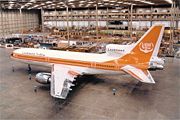
S-duct
Encyclopedia

Jet engine
A jet engine is a reaction engine that discharges a fast moving jet to generate thrust by jet propulsion and in accordance with Newton's laws of motion. This broad definition of jet engines includes turbojets, turbofans, rockets, ramjets, pulse jets...
intake duct, used in several types of trijet
Trijet
A Trijet is an aircraft powered by three jet engines. Early twin-jet designs were limited by the FAA's "60-minute rule", whereby the flight path of twin-engined jetliners was restricted to within 60 minutes' flying time from a suitable airport, in case of engine failure. In 1964 this rule was...
aircraft
Aircraft
An aircraft is a vehicle that is able to fly by gaining support from the air, or, in general, the atmosphere of a planet. An aircraft counters the force of gravity by using either static lift or by using the dynamic lift of an airfoil, or in a few cases the downward thrust from jet engines.Although...
. In this configuration, the intake is in the upper rear center of the aircraft, just below the stabilizer
Vertical stabilizer
The vertical stabilizers, vertical stabilisers, or fins, of aircraft, missiles or bombs are typically found on the aft end of the fuselage or body, and are intended to reduce aerodynamic side slip. It is analogical to a skeg on boats and ships.On aircraft, vertical stabilizers generally point upwards...
, while the exhaust is at the rear of the aircraft. The S-duct is located in the tail, or empennage
Empennage
The empennage , also known as the tail or tail assembly, of most aircraft gives stability to the aircraft, in a similar way to the feathers on an arrow...
, of the aircraft. The shape of the S-duct is distinctive and easily recognized, and was used in several aircraft, beginning in 1962 with the Hawker Siddeley Trident
Hawker Siddeley Trident
The Hawker Siddeley HS 121 Trident was a British short/medium-range three-engined jet airliner designed by de Havilland and built by Hawker Siddeley in the 1960s and 1970s...
. Currently, the Dassault Falcon 7X
Dassault Falcon 7X
|-See also:-External links:****...
and Dassault Falcon 900 business jets, and the Tupolev Tu-154M narrow-body airliner in limited production, are the only aircraft in production that use the S-duct design.
Benefits and drawbacks
The S-duct was invented as a solution for positioning the central engine on trijets. The S-duct was easier to service than alternative trijet designs. Most trijet designs opted for the S-duct layout.In fact, only the DC-10 and MD-11 trijets chose not to use the S-duct and go with a "straight-through" layout. The straight-through layout leaves the engine high above the ground, making access difficult. The straight layout also increases total aircraft drag
Drag (physics)
In fluid dynamics, drag refers to forces which act on a solid object in the direction of the relative fluid flow velocity...
by 2-4%.
On the L-1011, engineers were able to maintain straight-through engine performance by limiting the curve of the S-duct to less than 25% of the radius of the engine intake diameter. The S-duct design also reduced the total empty aircraft weight. The research undertaken during the design of the L-1011 indicated that losses of using an S-duct were more than compensated for by the above savings.
The S-shaped duct is a complicated and costly design. Since modern jet engines have more power and reliability than those of 1970s, and can safely power the aircraft with only two engines, the trijet design has currently fallen out of favour.
List of S-duct aircraft
Aircraft currently built with S-ducts are the:- Dassault Falcon 7XDassault Falcon 7X|-See also:-External links:****...
- Dassault Falcon 900
Aircraft previously built with S-ducts, but no longer in production, are the:
- Tupolev Tu-154M
- Boeing 727Boeing 727The Boeing 727 is a mid-size, narrow-body, three-engine, T-tailed commercial jet airliner, manufactured by Boeing. The Boeing 727 first flew in 1963, and for over a decade more were built per year than any other jet airliner. When production ended in 1984 a total of 1,832 aircraft had been produced...
- Dassault Falcon 50Dassault Falcon 50|-See also:-References:* Taylor, John W R. . Jane's All The World's Aircraft 1988-89. Coulsdon, Surrey, UK:Jane's Information Group. ISBN 0-7106-0867-5.-External links:* *...
- Hawker Siddeley TridentHawker Siddeley TridentThe Hawker Siddeley HS 121 Trident was a British short/medium-range three-engined jet airliner designed by de Havilland and built by Hawker Siddeley in the 1960s and 1970s...
- Lockheed L-1011Lockheed L-1011The Lockheed L-1011 TriStar, commonly referred to as the L-1011 or TriStar, is a medium-to-long range, widebody passenger trijet airliner. It was the third widebody airliner to enter commercial operations, following the Boeing 747 and the McDonnell Douglas DC-10. Between 1968 and 1984, Lockheed...
- Tupolev Tu-154Tupolev Tu-154The Tupolev Tu-154 is a three-engine medium-range narrow-body airliner designed in the mid 1960s and manufactured by Tupolev. As the mainstay 'workhorse' of Soviet and Russian airlines for several decades, it serviced over a sixth of the world's landmass and carried half of all passengers flown...
- Yakovlev Yak-40Yakovlev Yak-40The Yakovlev Yak-40 is a small, three-engined airliner that is often called the first regional jet transport aircraft...
- Yakovlev Yak-42Yakovlev Yak-42The Yakovlev Yak-42 is a 100/120-seat three-engined mid-range passenger jet. It was designed as a replacement for several obsolete Aeroflot jets as a mid-range passenger jet...
The Boeing 747-300 Trijet was designed with an S-duct layout, but never built.http://rides.webshots.com/photo/2162379980048918155wRzLzH

